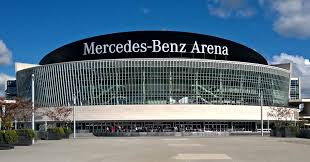Hamburg, Volksparkstadion
Like so many other stadiums in Germany, Volksparkstadion has carried a string of sponsors’ names recently. Now it is back to its original name, that can be roughly translated as the People’s Park Stadium. The new stadium can hold 51,500, turning its running track into more seating.
Düsseldorf, Esprit Arena
Perhaps Düsseldorf was the biggest loser in World Cup 2006 when the slots were doled out. In spite of a newly-renovated stadium, the city went empty-handed at the same time local rivals Cologne got the nod. The Esprit Arena is a cauldron inside it with a seating capacity of 51,000, though it resembles a giant DIY store. It’s also good to hide the odd empty seat here, the paint job means the stands always appear full.
Frankfurt, Commerzbank Arena
Located in Frankfurt, Commerzbank Arena has a seating capacity of 48,000 spectators. Germany’s financial capital on the Main river is also the DFB’s hometown and has already attracted more than its fair share of foreign guests. Germany’s football association is building a new headquarters near the stadium.
Stuttgart, Mercedes-Benz-Arena

For those who don’t know who helps keep VfB Stuttgart afloat, its name is a big clue. The state capital of Baden Württemberg is also the automotive hub of Germany, home to Mercedes and Porsche as well. This was also a World Cup 2006 stadium. Indeed, the German’s summer fairy tale concluded when Jürgen Klinsmann’s team beat Portugal in the third-place playoff.
Gelsenkirchen, Veltins-Arena
Situated atop a hill in the north of Gelsenkirchen, Veltins-Arena is the home stadium of Schalke. Named after a beer producer, it has a seating capacity of 54,740 spectators and is furnished with retractable roof that can come into play during bad weather. Veltins-Arena was the venue for FIFA World Cup 2006 and also used to host the World Team Challenge for the skiing and shooting biathlon for years now as well as other non-sporting events like concerts.